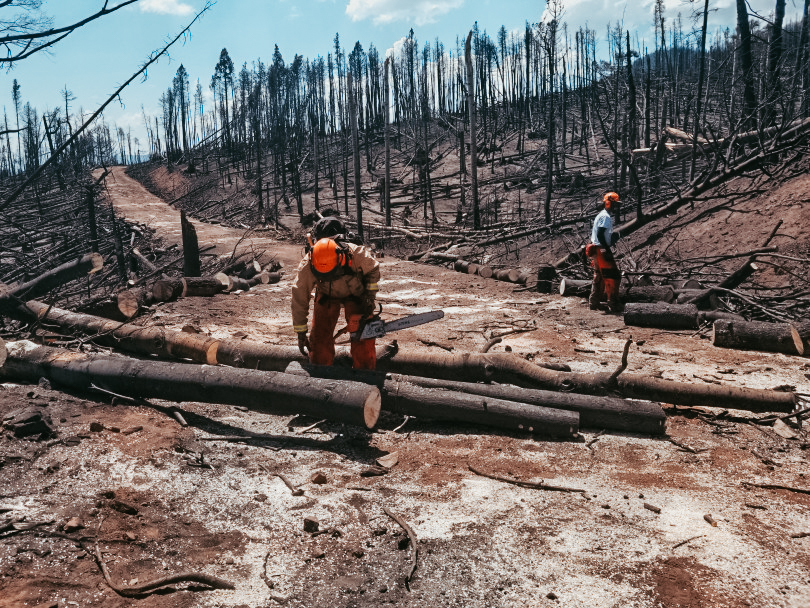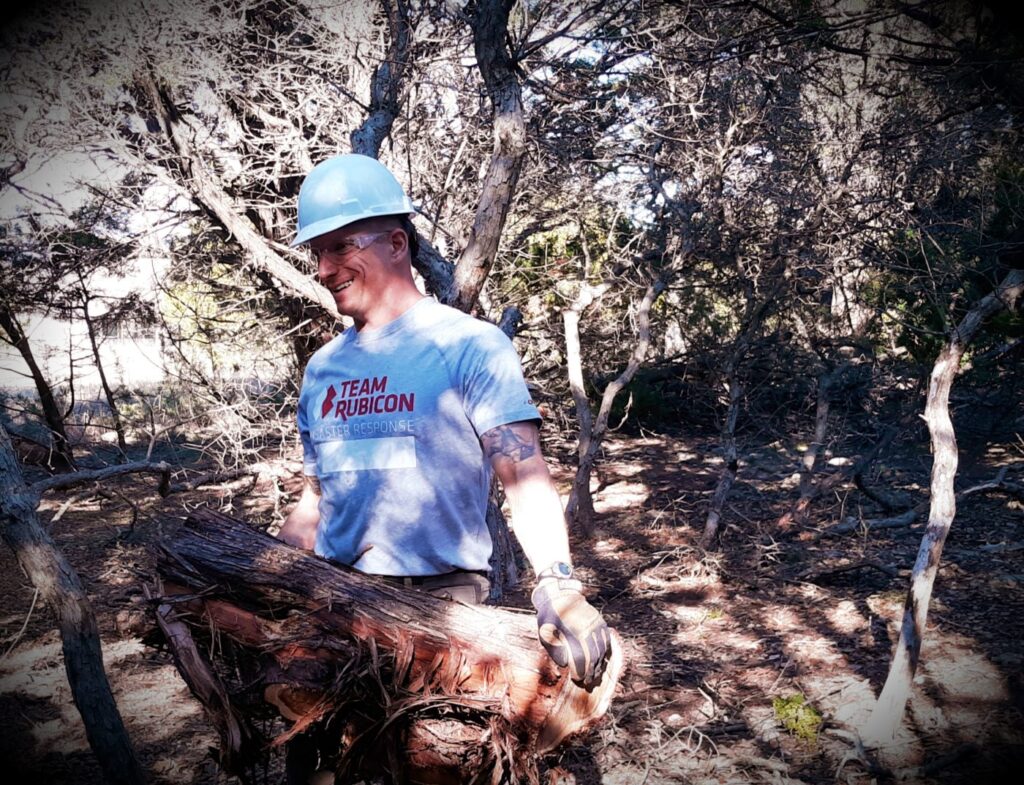The sun was already bright and warm when I pulled up at the Twin Springs Preserve in Williamson County, Texas just before 9 a.m. on a Sunday morning. Stepping out of my car, I shielded my eyes to take in the dense stands of ash juniper and white oak trees against the cloudless blue sky. It felt unusually spring-like for early February; I opted to shuck my jacket.
With my back to the road and neighborhood, I could imagine this area north of Austin as the verdant forest it once was. But the human population of Williamson County has tripled over the last several decades, encroaching on the wildland. In 2009, the county bought 175 acres to create a preserve and mitigate against the destruction of natural habitat. In addition to wild turkeys, foxes, deer, and raccoons, Twin Springs is home to several threatened or endangered species, including the bone cave harvestman spider, Salido salamander, and golden-cheeked warbler.
The beauty and peacefulness of the preserve belie a hidden danger. Here, the forest floor is strewn with grasses, shrubs, and the litter of fallen leaves and branches. In hot, dry conditions, those materials become tinder. All it takes is a sustained wind and an errant spark—from a discarded cigarette, say, a car’s exhaust system, or a lightning strike—for the tinder to catch fire. Unchecked, the flames can climb to the upper canopy and then quickly spread from tree to tree.

Canopy fires are intense, fast-moving, and virtually unstoppable says Kyle McKnight, an Emergency Management Specialist with Williamson County. “A canopy fire could very rapidly progress to these homeowners, causing millions of dollars of losses and potentially loss of human life as well,” he said. “Look at what is happening in California. We’ve seen a huge loss of life and property.”
$1 OF PREVENTION VS. $40 OF CURE
Greater Austin, which includes Williamson County, ranks fifth in the nation among metropolitan areas at risk for wildfires according to a recent report by CoreLogic, an online property data service. The only areas at greater risk are all in California.
Rather than wait to react to the inevitable wildfires, Williamson County officials put together a comprehensive plan to mitigate risk. “According to FEMA, [the Federal Emergency Management Association], on average, every $1 spent in mitigation results in $7 of saved cost from fighting the fires and recovery from damage,” says McKnight. In some areas with more expensive real estate, he says, the return is as high as $40 for every $1 invested in prevention.
The Williamson County mitigation plan calls for creating a 50-foot wide shaded fuel break along the perimeter of Twin Creeks Preserve, McKnight explains. The idea is to take out debris and shrubs, and remove tree limbs up to about 8 feet above ground, leaving the shaded canopy to keep the forest cooler and discourage the growth of flammable understory plants.

What Williamson County didn’t have, however, was the budget or manpower to carry out the work. That’s where Team Rubicon came in. For two weekends in February, teams of about 50 volunteers—known by Team Rubicon as Greyshirts—worked steadily to make the forest and surrounding neighborhoods safer by creating a shaded fuel break.
A BLUE-SKY OPERATION
The morning I arrive, the preserve is a beehive of activity. The insistent buzz of chainsaws and mechanical drone of woodchippers cut through the morning air. It smells amazing, like walking into a freshly built cedar closet.
Oscar Arauco, the Texas State Administrator for Team Rubicon, has me don a hard hat, goggles, and earplugs before we survey the worksite. As we walk, he explains that Team Rubicon coordinates “gray skies” operations to provide relief after disasters such as Hurricane Harvey, which roiled the Gulf coast in 2017, and “blue skies” prevention operations such as this that help mitigate risk. Often, Team Rubicon uses such mitigation work to further educate and train sawyers and other Greyshirts, too.
Like 70% of the people involved in Team Rubicon, Arauco is a military veteran, having served for 28 years as a U.S. Army artillery officer and chaplain. (The remaining members are affectionately known as kick-ass civilians, he explains.) Once Team Rubicon identifies a need and defines a project, a call for help goes out to members living within a 450-mile radius. With the exception of a couple of paid project managers, everyone here is a volunteer. Most have driven in for the weekend and are bunking on cots at the nearby First Baptist Church of Georgetown.

Arauco points out that the busy work site is well organized into sets of three teams, each supervised by a strike leader. People known as “sawyers” use pole saws and chainsaws to take out tree limbs and vegetation up to the 8-foot mark. “Swampers” carry the woody material to the perimeter where the “chippers” feed it into wood chippers to turn it into mulch that goes back into the preserve.
I’m struck by the diversity of Greyshirts and the lack of traditional hierarchies—a young woman is just as apt to be leading a team as an older man. That’s one of the things Arauco says he likes most about his work. “I love that Team Rubicon values service over any other factor,” he says. “There are no age- or gender-specific roles. It’s all about pulling your weight and getting the job done.”
FORMER ARMY MEDIC TURNS HER FOCUS TO HEALTHY FORESTS
M.D. Kidd, who takes a break from the chainsaw to talk, is one of the younger faces in the group. She served as a medic in the U.S. Army from 2011 to 2015 and then trained as a wildland firefighter for the Southwest Conservation Corp in Colorado. In 2017, she joined Team Rubicon and underwent training to become a regional chainsaw instructor. Now a full-time college student majoring in sociology and public health, Kidd says she would eventually like to work for the Peace Corps. For her, volunteering with Team Rubicon is the way to serve both people and the environment.
She points out that fire is a natural part of the cycle for healthy forests, but for more than a century people have focused on suppressing fires, leaving the tinder-like material to build up. “The longer we suppress fires and leave the fuel sitting there, the worse it is in the long run,” she said. “So efforts that mitigate the risk of fire are hugely important. As with medicine, I think prevention is really the way to go.”

Kidd and others say a big reason they volunteer on mitigation projects like this for Team Rubicon is the break from routine it provides, and the camaraderie. “The reason I am so passionate about this organization is that it provides a purpose for veterans,” says Patrick Smith, a 23-year U.S. Army veteran who is coordinating logistics for the operation. Smith works as a Deputy Sheriff in charge of animal cruelty for Harris County and as a physician’s assistant at Memorial Herman Hospital in Houston. “Team Rubicon takes our skills and experience and finds a place where they can be put to good use,” he says.
Greyshirt Keith Elwell, a former project engineer for the defense industry, joined in 2018 after seeing people in Houston trying to cope with the aftermath of Hurricane Harvey on the news. “Man, I’m sitting there just watching. I’m thinking ‘I’ve got some skills. I can help. I can do stuff’,” he says. He has now gained enough training and experience as a sawyer to mentor others.
Since then, he says, he’s “been all over the place”—from clearing trees felled by a fierce storm in Wisconsin to tearing down homes destroyed by Hurricane Michael in Panama City, Florida to cleaning up after the Mississippi River Flooded in Vicksburg, Tennessee. “There are all different roles and no two situations are the same,” he says. “I’ve been fortunate enough to help people on the worst day of their lives.”
OVER TWO WEEKENDS, MONTHS GET WHITTLED AWAY
It’s hard to put into words how meaningful the mitigation effort is to the county officials and inhabitants of this scenic area, says Mark Pettigrew, a Trails and Preserves Steward for Williamson County. We sat down on a couple of flat rocks in front of the trailhead and he gestured to the activity around us. “I’m one of only two main employees for the Williamson County Conservation Foundation. To get all this done would have taken us months and months,” he says.
Pettigrew points to the area in front of us, where the preserve abuts a busy road and neighborhood. The teams are mostly finished here and it looks like an arboretum with a wide, mulched path shaded by a graceful canopy of trees. “The most hazardous area is along this road and we’ve got the whole place completely cleared out and ready to go,” he says. “It’s phenomenal.”
Without the help of the Team Rubicon Greyshirts, it’s not clear when—or if—fire mitigation in the preserve would get done. As the county’s Emergency Management Specialist, McKnight says he knows that there’s currently no budget for the work. Grants often require extra steps and cost matching. “It’s a creative strategy for getting projects like this done,” says McKnight. “It requires a minimal investment on our behalf—some food and porta-potties—and we’re saving hundreds of thousands of dollars in labor costs. It’s a win-win.”
By the time I’d wrapped up, the day had shaped up to be unseasonably warm with low humidity—pleasant, but concerning, too, given what I had learned about wildfire risk. Climate change is bringing wave after wave of record heat to the Austin area. Last September was the hottest on record, with nearly three straight weeks of triple-digit temperatures.

On the way back to my car another Team Rubicon Greyshirt, Sam Brokenshire, stopped me. He wanted me to leave with a sense of scale for just how much the group had accomplished. At the end of the two-weekend project, he says, the team will have removed about 4,000 cubic yards—about 90 dumpsters worth—of brush.
Seeing people out working for the common good means a lot, says Brokenshire. “Yesterday, a guy from the neighborhood pulled up to thank us for the work we are doing,” he says. “That makes it all worth it.”
Want to fuel Team Rubicon’s wildfire mitigation efforts? Here’s how.



